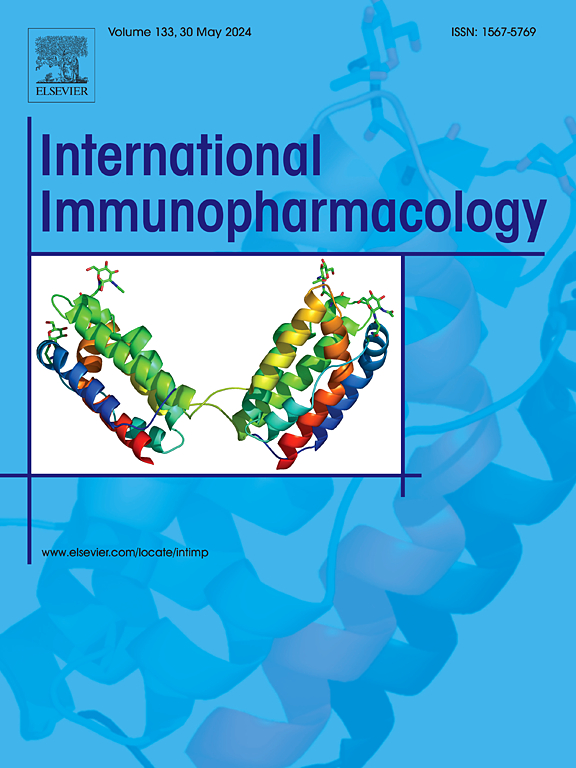GPR39 的病理生理功能和治疗潜力:聚焦激动剂和拮抗剂。
IF 4.8
2区 医学
Q2 IMMUNOLOGY
引用次数: 0
摘要
G 蛋白偶联受体 39(GPR39)是生长激素释放肽家族的成员之一,在各种组织中广泛表达,具有很高的组成活性,主要由锌离子激活。它通过招募 Gq/11、Gs、G12/13 和 β-restin 蛋白,在细胞增殖、分化、存活、凋亡和离子转运中发挥关键作用。GPR39 参与了抗炎和抗氧化反应,突显了其多样化的病理生理功能。最近发现的内源性配体加深了我们对 GPR39 生理作用的了解。GPR39 的异常表达和再激活与一系列疾病有关,尤其是中枢神经系统疾病、内分泌紊乱、心血管疾病、癌症和肝脏疾病。这些发现将 GPR39 定位为一个有前景的治疗靶点,合成配体的疗效已在各种体内模型中得到验证。然而,这些配体的临床适用性仍不确定,因此有必要进一步探索新型激动剂--尤其是偏性激动剂和拮抗剂。本综述探讨了导致 GPR39 高组成活性的独特残基、其内源配体和合成配体及其病理生理学意义,旨在阐明其在疾病治疗中临床应用的药理潜力。本文章由计算机程序翻译,如有差异,请以英文原文为准。
The pathophysiological functions and therapeutic potential of GPR39: Focus on agonists and antagonists
G protein-coupled receptor 39 (GPR39), a member of the growth hormone-releasing peptide family, exhibits widespread expression across various tissues and demonstrates high constitutive activity, primarily activated by zinc ions. It plays critical roles in cell proliferation, differentiation, survival, apoptosis, and ion transport through the recruitment of Gq/11, Gs, G12/13, and β-arrestin proteins. GPR39 is involved in anti-inflammatory and antioxidant responses, highlighting its diverse pathophysiological functions. Recent discoveries of endogenous ligands have enhanced our understanding of GPR39′s physiological roles. Aberrant expression and reactivation of GPR39 have been implicated in a range of diseases, particularly central nervous system disorders, endocrine disruptions, cardiovascular diseases, cancers, and liver conditions. These findings position GPR39 as a promising therapeutic target, with the efficacy of synthetic ligands validated in various in vivo models. Nonetheless, their clinical applicability remains uncertain, necessitating further exploration of novel agonists—especially biased agonists—and antagonists. This review examines the unique residues contributing to the high constitutive activity of GPR39, its endogenous and synthetic ligands, and its pathophysiological implications, aiming to elucidate its pharmacological potential for clinical application in disease treatment.
求助全文
通过发布文献求助,成功后即可免费获取论文全文。
去求助
来源期刊
CiteScore
8.40
自引率
3.60%
发文量
935
审稿时长
53 days
期刊介绍:
International Immunopharmacology is the primary vehicle for the publication of original research papers pertinent to the overlapping areas of immunology, pharmacology, cytokine biology, immunotherapy, immunopathology and immunotoxicology. Review articles that encompass these subjects are also welcome.
The subject material appropriate for submission includes:
• Clinical studies employing immunotherapy of any type including the use of: bacterial and chemical agents; thymic hormones, interferon, lymphokines, etc., in transplantation and diseases such as cancer, immunodeficiency, chronic infection and allergic, inflammatory or autoimmune disorders.
• Studies on the mechanisms of action of these agents for specific parameters of immune competence as well as the overall clinical state.
• Pre-clinical animal studies and in vitro studies on mechanisms of action with immunopotentiators, immunomodulators, immunoadjuvants and other pharmacological agents active on cells participating in immune or allergic responses.
• Pharmacological compounds, microbial products and toxicological agents that affect the lymphoid system, and their mechanisms of action.
• Agents that activate genes or modify transcription and translation within the immune response.
• Substances activated, generated, or released through immunologic or related pathways that are pharmacologically active.
• Production, function and regulation of cytokines and their receptors.
• Classical pharmacological studies on the effects of chemokines and bioactive factors released during immunological reactions.

 求助内容:
求助内容: 应助结果提醒方式:
应助结果提醒方式:


